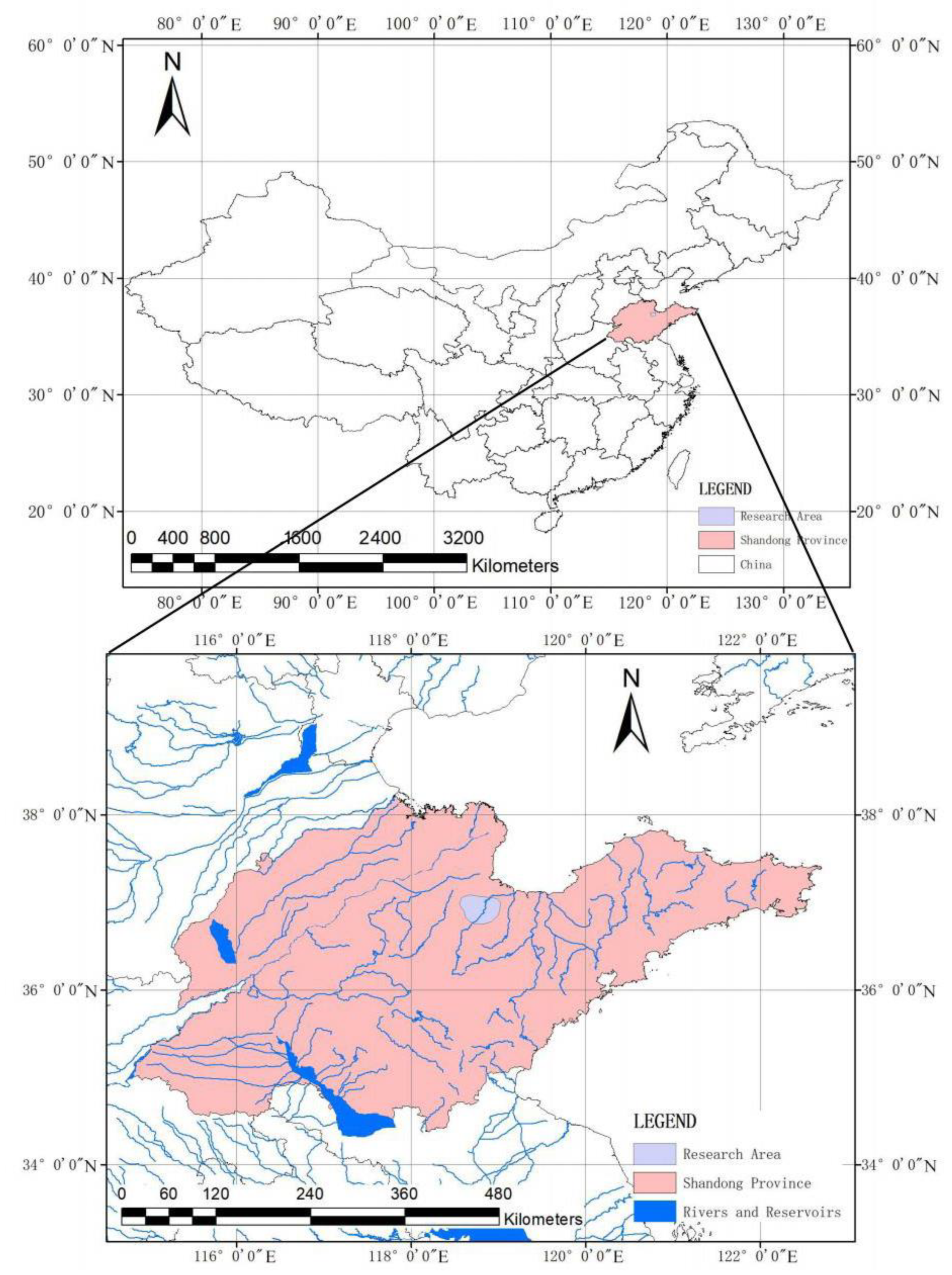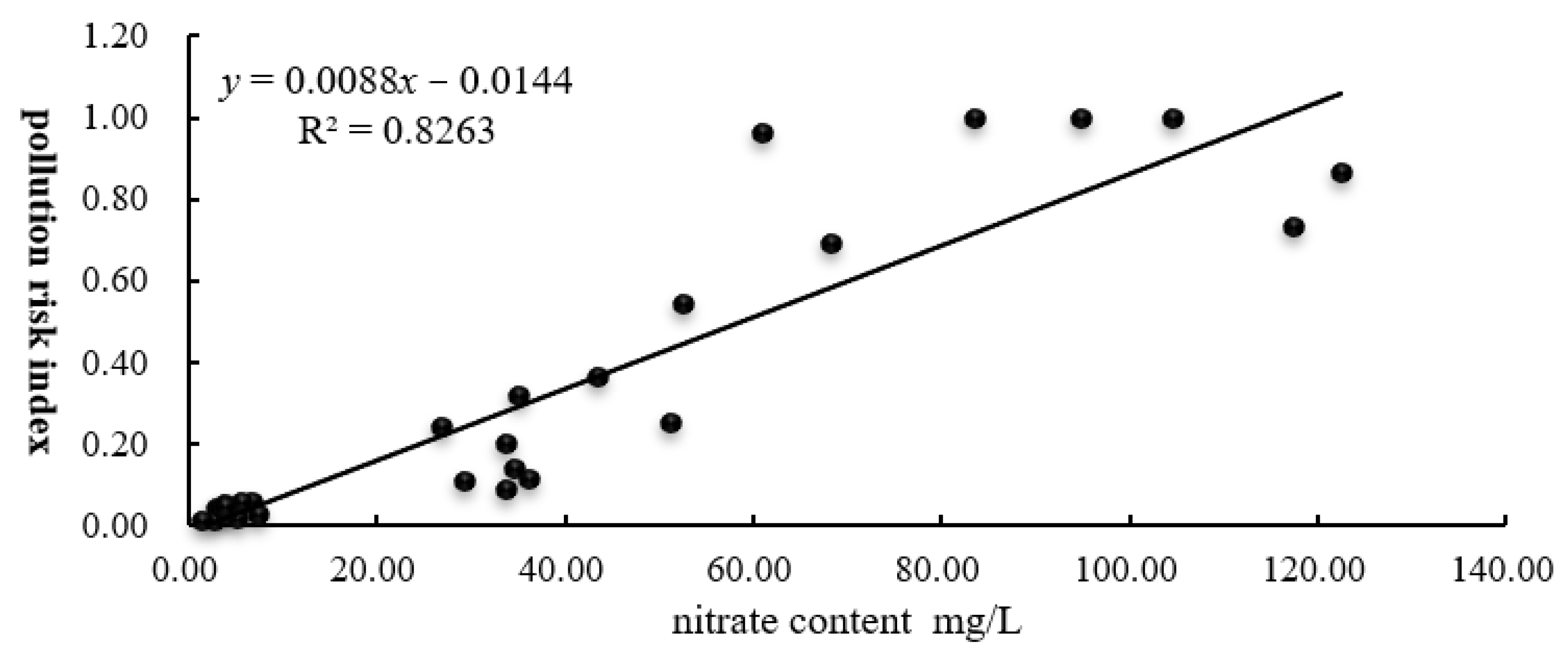Risk Assessment of Nitrate Pollution in the Shallow Groundwater of the Mihe Alluvial–Diluvial Fan Based on a DEA Model
Abstract
:1. Introduction
2. Materials and Methods
2.1. Overview of Study Area
2.2. Pollution Path
2.3. Sample Acquisition
2.4. Methods
2.5. Variable Analysis
2.6. Calculation
3. Results
3.1. Water Quality Characteristics
3.2. Traceability Analysis of Nitrate Pollution in Groundwater
3.3. Nitrate Pollution Risk
3.4. Reliability Analysis
4. Discussion
5. Conclusions
- (1)
- The overall pollution index of the study area is low, but the spatial variability is high, and the difference of spatial distribution is obvious, which is reflected in the higher pollution risk in the area with higher vegetable planting density and the lower pollution risk in the area with lower vegetable planting density in the north.
- (2)
- The groundwater quality in most of the middle and lower reaches of Mihe alluvial fan meets the class III water standard of groundwater quality, but the nitrate content in some areas in the south is more than 20 mg/L, which exceeds the class III water limit.
- (3)
- Agricultural production and livestock breeding are the main sources of nitrogen emissions, and the nitrogen discharged into groundwater by leaching, nitrification, and other chemical reactions results in nitrate contents in the groundwater beyond the set limits.
Author Contributions
Funding
Acknowledgments
Conflicts of Interest
References
- Thorburn, P.J.; Biggs, J.S.; Weier, K.L.; Keating, B.A. Nitrate in Groundwaters of Intensive Agricultural Areas in Coastal Northeastern Australia. Agric. Ecosyst. Environ. 2003, 94, 49–58. [Google Scholar] [CrossRef]
- Rosenstock, T.S.; Liptzin, D.; Dzurella, K.; Fryjoff-Hung, A.; Hollander, A.; Jensen, V.; King, A.; Kourakos, G.; McNally, A.; Pettygrove, G.S.; et al. Agriculture’s Contribution to Nitrate Contamination of Californian Groundwater (1945–2005). J. Environ. Qual. 2014, 43, 895–907. [Google Scholar] [CrossRef] [Green Version]
- Wang, Y.G.; Wang, H.Y.; Zheng, Y.L.; Sun, X.Y. Advances in Research Methods and Control Technologies of Agricultural Non-Point Source Pollution: A Review. Chin. J. Agric. Resour. Reg. Plan. 2021, 42, 25–33. [Google Scholar]
- Ju, X.-T.; Xing, G.-X.; Chen, X.-P.; Zhang, S.-L.; Zhang, L.-J.; Liu, X.-J.; Cui, Z.-L.; Yin, B.; Christie, P.; Zhu, Z.-L.; et al. Reducing Environmental Risk by Improving N Management in Intensive Chinese Agricultural Systems. Proc. Natl. Acad. Sci. USA 2009, 106, 3041–3046. [Google Scholar] [CrossRef] [PubMed] [Green Version]
- Infascelli, R.; Pelorosso, R.; Boccia, L. Spatial Assessment of Animal Manure Spreading and Groundwater Nitrate Pollution. Geospat Health 2009, 4, 27–38. [Google Scholar] [CrossRef] [PubMed] [Green Version]
- Ma, L.; Lu, J.; Zhao, J. Nitrate Vulnerable Zones and strategies of non-point pollution mitigation in China. J. Agro-Environ. Sci. 2018, 37, 2387–2391. [Google Scholar]
- Zhao, T.K. Nitrate Pattern and Control of Groundwater in Pan-Rim Bohai Sea Area; Science Press: Beijing, China, 2014. [Google Scholar]
- Machiwal, D. Identifying Sources of Groundwater Contamination in a Hard-Rock Aquifer System Using Multivariate Statistical Analyses and GIS-Based Geostatistical Modeling Techniques. J. Hydrol. 2015, 4, 80–110. [Google Scholar] [CrossRef] [Green Version]
- Mester, T.; Szabó, G.; Balla, D. Assessment of Shallow Groundwater Purification Processes after the Construction of a Municipal Sewerage Network. Water 2021, 13, 1946. [Google Scholar] [CrossRef]
- Wendland, F.; Bergmann, S.; Eisele, M.; Gömann, H.; Herrmann, F.; Kreins, P.; Kunkel, R. Model-Based Analysis of Nitrate Concentration in the Leachate—The North Rhine-Westfalia Case Study, Germany. Water 2020, 12, 550. [Google Scholar] [CrossRef] [Green Version]
- Hu, K.L.; Li, B.G.; Huang, Y.F. Stochastic simulation and risk assessment of nitrate leaching at field scale. Acta Pedol. Sin. 2005, 42, 909–915. [Google Scholar]
- Shaffer, M.J.; Halvorson, A.D.; Pierce, F.J. Nitrate Leaching and Economic Analysis Package (NLEAP): Model Description and Application. In Managing Nitrogen for Groundwater Quality and Farm Profitability; Follett, R.F., Keeney, D.R., Cruse, R.M., Eds.; Soil Science Society of America: Madison, WI, USA, 2015; pp. 285–322. ISBN 978-0-89118-877-3. [Google Scholar]
- Ramos, C. Nitrate Leaching and Soil Moisture Prediction with the LEACHM Model. Fertil. Res. 1991, 27, 171–180. [Google Scholar] [CrossRef]
- Hansen, S.; Jensen, H.E.; Nielsen, N.E. Simulation of Nitrogen Dynamics and Biomass Production in Winter Wheat Using the Danish Simulation Model DAISY. Fertil. Res. 1991, 27, 245–259. [Google Scholar] [CrossRef]
- Hanson, J.D.; Ahuja, L.R.; Shaffer, M.D.; Rojas, K.W.; DeCoursey, D.G.; Farahani, H.; Johnson, K. RZWQM: Simulating the Effects of Management on Water Quality and Crop Production. Agric. Syst. 1998, 57, 161–195. [Google Scholar] [CrossRef]
- Cao, Q.H.; Gong, Y.S. Simulation and analysis of water balance and nitrogen leaching using Hydrus-1D under winter wheat crop. Plant Nutr. Fertil. Sci. 2003, 9, 139–145. [Google Scholar]
- Liu, P.B.; Ding, Y.Y.; Zhang, Y.F. The study of 1-dimension saturated-unsaturated mathematical model of nirigen transport and transformation for the field conditions. J. Shenyang Norm. Univ. 2000, 37, 490–497. [Google Scholar]
- Shrestha, A.; Luo, W. Assessment of Groundwater Nitrate Pollution Potential in Central Valley Aquifer Using Geodetector-Based Frequency Ratio (GFR) and Optimized-DRASTIC Methods. IJGI 2018, 7, 211. [Google Scholar] [CrossRef] [Green Version]
- Jarray, H.; Zammouri, M.; Ouessar, M.; Zerrim, A.; Yahyaoui, H. GIS Based DRASTIC Model for Groundwater Vulnerability Assessment: Case Study of the Shallow Mio-Plio-Quaternary Aquifer (Southeastern Tunisia). Water Resour. 2017, 44, 595–603. [Google Scholar] [CrossRef]
- Lu, Y.Y.; Li, P.P. Effects of applocation of nitrogen fertilizer on pollutions. J. Shenyang Norm. Univ. 2014, 32, 1–5. [Google Scholar]
- Gao, X.Q.; Gao, J.Y.; Zhang, N. Variation Characteristics of Precipitation, Rain Days and Rainfall Intensity in Shouguang During Recent 56 Years. Chin. Agric. Sci. Bull. 2016, 32, 106–112. [Google Scholar]
- Mosier, A.; Syers, J.K.; Freney, J.R. Agriculture and the Nitrogen Cycle: Assessing the Impacts of Fertilizer Use on Food Production and the Environment; Island Press: Washington, DC, USA, 2004; Volume 65. [Google Scholar]
- Cameron, K.C.; Di, H.J.; Moir, J.L. Nitrogen Losses from the Soil/Plant System: A Review: Nitrogen Losses. Ann. Appl. Biol. 2013, 162, 145–173. [Google Scholar] [CrossRef]
- Rivett, M.O.; Buss, S.R.; Morgan, P.; Smith, J.W.N.; Bemment, C.D. Nitrate Attenuation in Groundwater: A Review of Biogeochemical Controlling Processes. Water Res. 2008, 42, 4215–4232. [Google Scholar] [CrossRef] [PubMed]
- Tucker, T.C.; Westerman, R.L. Gaseous Losses of Nitrogen from Desert Region Soils. Arid. Soil Res. Rehabil. 1989, 3, 267–280. [Google Scholar] [CrossRef]
- Yang, G.L.; Liu, W.B.; Zheng, H.J. Review of date envelopment analysis. J. Syst. Eng. 2013, 28, 840–860. [Google Scholar]
- Fan, L.; Yuan, Y.; Ying, Z.; Lam, S.K.; Liu, L.; Zhang, X.; Liu, H.; Gu, B. Decreasing Farm Number Benefits the Mitigation of Agricultural Non-Point Source Pollution in China. Environ. Sci. Pollut. Res. 2019, 26, 464–472. [Google Scholar] [CrossRef]
- Zou, L.; Liu, Y.; Wang, Y.; Hu, X. Assessment and Analysis of Agricultural Non-Point Source Pollution Loads in China: 1978–2017. J. Environ. Manag. 2020, 263, 110400. [Google Scholar] [CrossRef]
- Zhang, T.; Ni, J.; Xie, D. Assessment of the Relationship between Rural Non-Point Source Pollution and Economic Development in the Three Gorges Reservoir Area. Environ. Sci. Pollut. Res. 2016, 23, 8125–8132. [Google Scholar] [CrossRef]
- Yang, R.; Zhang, J.; Xu, Q.; Luo, X. Urban-Rural Spatial Transformation Process and Influences from the Perspective of Land Use: A Case Study of the Pearl River Delta Region. Habitat Int. 2020, 104, 102234. [Google Scholar] [CrossRef]
- Yang, C.; Liu, H.; Li, Q.; Cui, A.; Xia, R.; Shi, T.; Zhang, J.; Gao, W.; Zhou, X.; Wu, G. Rapid Urbanization Induced Extensive Forest Loss to Urban Land in the Guangdong-Hong Kong-Macao Greater Bay Area, China. Chin. Geogr. Sci. 2021, 31, 93–108. [Google Scholar] [CrossRef]
- Lu, H.; Xie, H. Impact of Changes in Labor Resources and Transfers of Land Use Rights on Agricultural Non-Point Source Pollution in Jiangsu Province, China. J. Environ. Manag. 2018, 207, 134–140. [Google Scholar] [CrossRef]
- Zhang, Y.; Yu, Q. Identification of Current Research Intensity and Influence Factors of Agricultural Nitrogen Loss from Cropping Systems. J. Clean. Prod. 2020, 276, 123308. [Google Scholar] [CrossRef]





| No. | Items | Class I | Class II | Class III | Class IV | Class V |
|---|---|---|---|---|---|---|
| 1 | pH | 6.5 ≤ pH ≤ 8.5 | 5.5 ≤ pH ≤ 6.5 8.5 ≤ pH ≤ 9.0 | pH < 5.5 or pH > 9.0 | ||
| 2 | Total hardness (mg/L) | ≤150 | ≤300 | ≤450 | ≤650 | >650 |
| 3 | Ammonia nitrogen (mg/L) | ≤0.02 | ≤0.10 | ≤0.50 | ≤1.50 | >1.5 |
| 4 | Nitrite (mg/L) | ≤0.01 | ≤0.1 | ≤1.00 | ≤4.80 | >4.8 |
| 5 | Nitrate (mg/L) | ≤2.0 | ≤5.0 | ≤20.0 | ≤30.0 | >30.0 |
| 6 | Chloride (mg/L) | ≤50 | ≤150 | ≤250 | ≤350 | >350 |
| Pollution Source | Ammonia Nitrogen | TN | ||
|---|---|---|---|---|
| Pollution Load (t·hm−2) | Contribution Rate | Pollution Load (t·hm−2) | Contribution Rate | |
| Domestic pollution | 186.52 | 7.08% | 223.82 | 2.59% |
| Livestock and Poultry Breeding | 331.74 | 12.58% | 1504.67 | 17.41% |
| Field planting | 1962.72 | 74.46% | 215.90 | 2.50% |
| Facility vegetables | 155.06 | 5.88% | 3749.41 | 43.38% |
| Other | 2949.61 | 34.12% | ||
| Total | 2636.04 | 100% | 8643.40 | 100% |
| No. | Sampling Point | No. | Sampling Point | No. | Sampling Point | No. | Sampling Point | ||||
|---|---|---|---|---|---|---|---|---|---|---|---|
| 1 | LC-1 | 1.000 | 8 | GC-1 | 0.252 | 15 | HL-2 | 0.139 | 22 | SC-3 | 1.000 |
| 2 | LC-2 | 0.690 | 9 | GC-2 | 0.030 | 16 | SK-1 | 0.014 | 23 | WJ-1 | 0.088 |
| 3 | LC-3 | 0.363 | 10 | TT-1 | 0.042 | 17 | TL-1 | 0.243 | 24 | JT-1 | 0.867 |
| 4 | LC-4 | 0.317 | 11 | TT-2 | 0.055 | 18 | TL-2 | 0.013 | 25 | JT-2 | 0.201 |
| 5 | LC-5 | 0.058 | 12 | HL-1 | 0.017 | 19 | SC-1 | 0.056 | 26 | JT-3 | 1.000 |
| 6 | DT-1 | 0.732 | 13 | HZ-2 | 0.048 | 20 | SC-2 | 0.964 | 27 | JT-3(H) | 0.042 |
| 7 | DT-2 | 0.111 | 14 | HZ-3 | 0.544 | 21 | SUNJ-1 | 0.115 | 28 | HZ-1 | 0.031 |
Publisher’s Note: MDPI stays neutral with regard to jurisdictional claims in published maps and institutional affiliations. |
© 2022 by the authors. Licensee MDPI, Basel, Switzerland. This article is an open access article distributed under the terms and conditions of the Creative Commons Attribution (CC BY) license (https://creativecommons.org/licenses/by/4.0/).
Share and Cite
Zhao, Q.; Li, F.; Zhu, A.; Zhang, X.; Chen, H.; Sun, T. Risk Assessment of Nitrate Pollution in the Shallow Groundwater of the Mihe Alluvial–Diluvial Fan Based on a DEA Model. Water 2022, 14, 1360. https://doi.org/10.3390/w14091360
Zhao Q, Li F, Zhu A, Zhang X, Chen H, Sun T. Risk Assessment of Nitrate Pollution in the Shallow Groundwater of the Mihe Alluvial–Diluvial Fan Based on a DEA Model. Water. 2022; 14(9):1360. https://doi.org/10.3390/w14091360
Chicago/Turabian StyleZhao, Qi, Fulin Li, Aihua Zhu, Xiaoming Zhang, Huawei Chen, and Tingting Sun. 2022. "Risk Assessment of Nitrate Pollution in the Shallow Groundwater of the Mihe Alluvial–Diluvial Fan Based on a DEA Model" Water 14, no. 9: 1360. https://doi.org/10.3390/w14091360
APA StyleZhao, Q., Li, F., Zhu, A., Zhang, X., Chen, H., & Sun, T. (2022). Risk Assessment of Nitrate Pollution in the Shallow Groundwater of the Mihe Alluvial–Diluvial Fan Based on a DEA Model. Water, 14(9), 1360. https://doi.org/10.3390/w14091360







